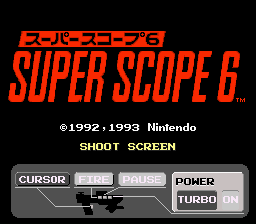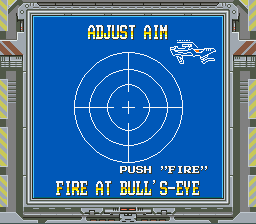Retro Replay Review
Gameplay
Super NES Super Scope 6’s gameplay is defined by its reliance on the Super Scope peripheral, turning your Super NES into a makeshift shooting gallery. From the moment you power on the game, you’re encouraged to pick up the massive light gun and aim at the screen. The calibration process is straightforward, but mastering the Super Scope’s ergonomics and aiming reticle takes patience. Each of the six distinct modes uses the same aiming mechanics, yet each offers a unique spin on what it means to “shoot” in a Super NES title.
The Blastris modes blend puzzle and shooting genres in intriguing ways. In Blastris A, blocks slide across the screen Tetris-style, and you have to zap individual segments to complete lines. Blastris B channels Columns and Puyo Puyo with its jelly-block matching, forcing you to quickly cycle colors with your shots. Finally, Mole Patrol flips expectations with a Whack-a-Mole approach, where timing and quick reflexes are essential to prevent cute critters from escaping the screen.
LaserBlazer ups the ante with pure first-person shooting missions wrapped in a military motif. Type A: Intercept tasks you with downing incoming missiles and planes, requiring both accuracy and ammo conservation as you monitor a radar display. Type B: Engage introduces returning fire, adding an element of defense and limited energy management to an already tense scenario. Type C: Confront pits you against agile UFOs that can fire anywhere on the screen, demanding pinpoint shots under pressure.
Across all six modes, difficulty ramps steadily, encouraging repeat playthroughs on higher settings. The limited ammo in LaserBlazer modes and the speed increase in Blastris levels ensure that even experienced players stay on their toes. While none of the individual game types are especially deep on their own, the variety and challenge combine to create a surprisingly robust package for a pack-in title.
Graphics
Graphically, Super Scope 6 embraces the SNES’s colorful palette but keeps things simple to ensure clarity during shooting sequences. The backgrounds in Blastris modes are clean and unobtrusive, allowing brightly colored blocks to stand out against minimal patterns. Mole Patrol’s cheerful sprites pop off the screen, and the animation of popping moles feels satisfying when punctuated by a well-placed shot.
LaserBlazer’s visual language is more utilitarian, employing straightforward wireframe overlays, blocky enemy sprites, and a radar screen that represents targets with simple blips. This pared-down aesthetic might not impress those looking for Mode 7 pizazz, but it prioritizes readability over flash, which is crucial when every shot counts.
The reticle itself is well-designed, featuring a dot or crosshair that remains sharp even as fast-moving targets zip across the screen. Calibration screens are serviceable, though occasional light bleed from older CRT televisions of the era could slightly throw off your aim. Overall, the graphics serve the gameplay effectively, ensuring targets are easy to identify in both puzzle and shooting segments.
Given that the Super Scope requires a darkened room and a CRT display to perform at its best, some modern players might find the visual experience feels dated. However, fans of retro hardware will appreciate how the visuals showcase the SNES’s strengths—bold colors, clear sprites, and smooth animation—while avoiding unnecessary graphical bloat.
Story
Super Scope 6 isn’t a narrative-driven experience, so “story” here is more about thematic context than plot twists. The Blastris modes lean into arcade abstraction—there’s no overt storyline connecting falling blocks or moles to an overarching tale. Instead, these modes focus on pure gameplay loops, emphasizing score-chasing and high-speed reflexes.
The LaserBlazer segment loosely frames each game type as military training exercises. Type A’s interception drills, Type B’s defensive engagements, and Type C’s fleet confrontations are presented as missions from a fictional defense command. This setup offers just enough context to justify the crosshairs, ammo counters, and radar readouts, creating a veneer of purpose for your shooting practice.
While there’s no character to root for or narrative milestones to unlock, the variety of mission briefings and target icons help differentiate each level thematically. You’ll feel like a trainee gunning down missiles in one moment and defending against alien incursions the next, even if the backstory remains minimal and implied rather than spelled out.
For players seeking deep lore or branching narratives, Super Scope 6 will feel light. Yet its lack of story allows it to focus squarely on gameplay innovation for a peripheral launch title, making it an interesting historical artifact in the annals of Nintendo hardware launches.
Overall Experience
As a pack-in title, Super Scope 6 succeeds in showcasing the peripheral’s potential more than delivering a blockbuster gaming adventure. The variety of modes—from block-blasting puzzles to first-person military simulators—keeps the game fresh and highlights how the Super Scope can diversify standard SNES fare. Each mode is bite-sized, making it easy to jump in for quick sessions or marathon training drills.
The primary barrier to entry is hardware: you need a functioning Super Scope, an SNES, and a CRT TV in good calibration. For collectors and retro enthusiasts, however, this package represents a unique slice of ’90s gaming history and delivers an experience you can’t replicate with standard controllers. The tactile satisfaction of aiming a light gun remains its greatest selling point.
Replayability is bolstered by adjustable difficulty levels, high-score challenges in Blastris modes, and increasingly aggressive enemy behavior in LaserBlazer stages. Though none of the six modes is especially deep by modern standards, the combined runtime offers solid value—and the novelty of the Super Scope elevates the overall fun factor.
Ultimately, Super NES Super Scope 6 is best suited for gamers curious about retro peripherals or those looking to complete their SNES collection. Its pack-in status ensures it’s more of a tech demo than a sprawling epic, but as a showcase of light-gun gameplay and inventive puzzle-shooter hybrids, it hits the mark admirably. Prospective buyers should be aware of the hardware requirements but can expect an engaging, unique experience once everything is set up correctly.
 Retro Replay Retro Replay gaming reviews, news, emulation, geek stuff and more!
Retro Replay Retro Replay gaming reviews, news, emulation, geek stuff and more!









Reviews
There are no reviews yet.